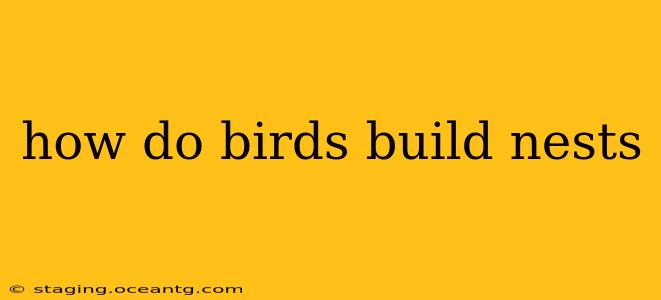Birds' nests are marvels of natural engineering, varying dramatically in size, shape, and material depending on the species. Understanding how birds build these intricate structures reveals fascinating insights into their behavior, adaptability, and survival strategies. This guide delves into the intricacies of bird nest construction, answering common questions and exploring the diverse approaches birds take.
What materials do birds use to build nests?
The materials birds use are incredibly diverse and often reflect what's readily available in their environment. Common materials include:
- Twigs and Sticks: These form the structural base of many nests, providing strength and stability. Larger, tougher twigs are often used in the foundation, with smaller, more flexible pieces woven into the interior.
- Grass and Leaves: These softer materials offer insulation and cushioning, creating a comfortable lining for the eggs and chicks.
- Moss and Lichens: These provide excellent camouflage, blending the nest seamlessly into its surroundings.
- Mud and Clay: Used by some species to create a strong, cup-shaped structure, often reinforced with other materials.
- Spiders' Silk: Incredibly strong and lightweight, spiders' silk acts as a natural binder, holding together other materials.
- Feathers: Provide insulation and softness, often used as a lining for the nest cup.
- Hair and Fur: Adds warmth and comfort to the nest interior.
- Human-made materials: Sadly, some birds incorporate human-made debris like string, plastic, and even cigarette butts, highlighting the impact of human activity on their environment.
How do different types of birds build their nests?
Bird nest construction varies greatly depending on the species and their specific needs. Some common nest types include:
- Cup nests: These are the most common type, shaped like a cup or bowl and often suspended from tree branches. Many songbirds construct cup nests.
- Platform nests: Large, flat nests built on sturdy branches or platforms, often used by larger birds like eagles and ospreys.
- Cavity nests: These nests are built inside holes in trees or rock crevices. Woodpeckers excavate their own cavities, while other birds utilize pre-existing holes.
- Scrape nests: Simple depressions in the ground, lined with minimal materials. Often used by ground-nesting birds like many shorebirds.
- Pendant nests: Elaborate, hanging nests suspended from branches, often characterized by intricate weaving techniques. Examples include weaver bird nests.
How long does it take a bird to build a nest?
The time it takes to build a nest varies significantly depending on the species and complexity of the structure. Some simple nests might be completed in a few days, while more complex nests can take several weeks. The size and building materials also influence construction time.
What is the purpose of a bird's nest?
The primary purpose of a bird's nest is to provide a safe and secure place for eggs to be laid and incubated, and for chicks to be raised. The nest protects the eggs and young from predators, harsh weather conditions, and other environmental threats. The materials used and nest design directly contribute to fulfilling this crucial role.
Do all birds build nests?
No, not all birds build nests. Some species, like the brown cuckoo, are brood parasites. They lay their eggs in the nests of other birds, leaving the responsibility of incubation and chick-rearing to the host bird. Other birds, like some seabirds, may simply lay their eggs directly on the ground or rock ledges.
How do birds know how to build nests?
Nest-building is largely an instinctive behavior, passed down through generations. Young birds often learn by observing their parents, perfecting their techniques through practice. However, there is also a significant innate component to nest construction; birds seem to have a pre-programmed understanding of the basic structure and materials required for their species-specific nest.
Why are some bird nests more elaborate than others?
The complexity of a bird's nest is often related to the species' evolutionary history, environmental pressures, and reproductive strategies. Birds in areas with abundant predators or harsh weather conditions may build more elaborate and protective nests. The availability of building materials also plays a role.
By understanding the intricacies of bird nest construction, we gain a deeper appreciation for the ingenuity and adaptability of these fascinating creatures. The variation in nest design, materials, and construction methods reflects the incredible diversity within the avian world. The next time you see a bird's nest, take a moment to consider the incredible effort and skill that went into its creation.
